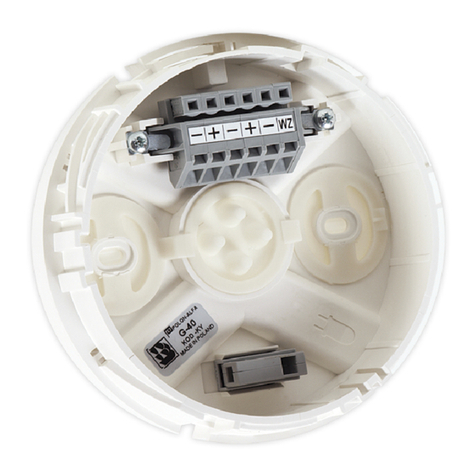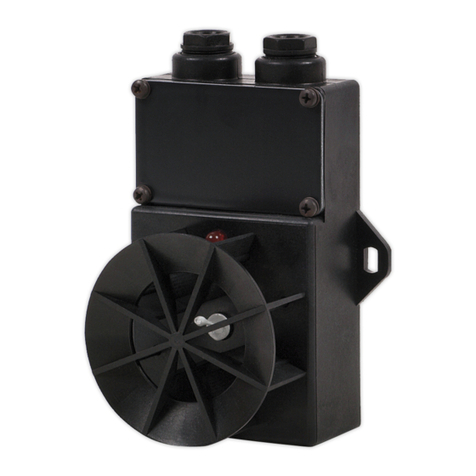IK-E283-001GB 5
-as a rate-of-rise heat detector - when a rapid rise of temperature exceeds the level
determined for the detector, pursuant to its given class.
A microcontroller monitors the detector operation, collecting data concerning the ambient
temperature around the detecting circuit, carries out measurement analyses, makes decisions, and is
responsible for communication between the detector and the fire detection control panel.
The detector alarm mode is signalled with flashing light of a red diode which is located in the
detector casing. The indicator enables quick location of the activated detector and is helpful during
periodic detector operation inspections. In case the detector is poorly visible or installed in hardly
accessible place, it can be furnished with an additional optical actuation indicator that should be
mounted in an accessible and visible place.
Communication between the POLON 4000 (POLON 6000) system fire alarm control panel and the
TUN-4046 detectors is provided using a two-wire addressable detection line. A unique, fully digital
communication protocol enables passing any information from the control panel to the detector and
inversely.
Apart from sending to the control panel the temperature value estimation and a tendency of its
change, the detector can transmit –on the control panel request –the current analogue value.
The detector operation controlling microprocessor monitors its basic systems proper operation and,
in a case of irregularity, delivers relevant information to the control panel.
The detector is equipped with an internal short circuiting insulator that cuts off an efficient part of
detection line from the neighbouring shorted section what enables the detector further undisturbed
operation. the alarm mode is indicated with pulse red light emitted by the signalling diode. The fault
mode, technical alarm, and short circuit isolator actuation are signalled with yellow flashes of the
illuminating diode.
The detector is furnished with a possibility to choose a way of reaction in the installation place,
pursuant to a given class. It is the TUN-4046 heat detector so called operation mode. A choice of one
of the following classes: A1, A2, B, A2S, BS, A1R, A2R or BR is made from the control panel level. The
detector with the class set as A2S, BR operates only in a fixed-temperature mode. All operation
modes are accordant with the PN-EN 54-5 standard. The detector operation modes (besides alarm
variants in the control panel) provide the user with an opportunity to adapt, in the best way, the
system operation characteristic to the determined environment conditions.
The TUN-4046 programming procedure is described in the POLON 4900 control panel programming
manual.
6 OPERATION AND SERVICING CONDITIONS
During the detectors operation it is necessary to avoid creation of dew or rime on the detector
surface as well as to protect against excessive dust contamination.
In case of any repair works the detector should be taken out (with consideration of p. 3.1) or
protected with a provided-for-this-purpose cover. Such covers can be obtained from an installer or
purchased from the manufacturer. If the detector is taken out, the base should be protected
against painting with a help of painting tape. Detectors which are damaged during renovation or
painting works due to a fault of executing persons (e.g. painted detector casing) are not subject to
warranty repairs.
The TUN-4046 should be subjected to periodic inspection according to the PKN-CEN/TS 54-14:2006
which is carried out in order to confirm the detector proper operation and its appropriate
interoperation with the control panel. The inspection should be conducted at least once in 6 months.



























